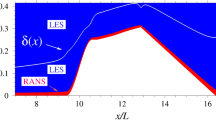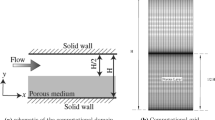Abstract
This work presents a numerical study of turbulent channel flows with combined convective and radiative heat transfer in participating media by means of large Eddy simulation and Reynolds averaged Navier–Stokes (RANS) with k–ε model. The main purpose is to evaluate the employment of the traditional modeling (RANS without TRI) for the prediction of time-averaged parameters of turbulent non-reactive flows with convective and radiative heat transfer. All cases are investigated with Re τ = 180, Pr = 0.71 and for various optical thicknesses: τ 0 = 0.01, 0.1, 1.0, 10 and 100. In spite of the consideration of non-relevance of turbulence–radiation interactions for non-reactive turbulent flows, the results shown that for τ 0 ≥10 the employment of RANS with k–ε model led to considerable deviations for the prediction of time-averaged radiative fluxes and divergence of the radiative fluxes. For τ 0 = 100, both models also led to different results for the time-averaged convective fluxes.












Similar content being viewed by others
Abbreviations
- C s(x, t):
-
Smagorinsky constant
- G :
-
Total radiative incidence, W/m2
- g i :
-
Gravity acceleration in i-direction, i = 1, 2 and 3, m/s²
- H :
-
Channel height, m
- i :
-
Total radiative intensity, W/(m2 sr)
- i b :
-
Total blackbody intensity, W/(m2 sr)
- k :
-
Turbulent kinetic energy, m2/s2
- L :
-
Channel length, m
- P :
-
Pressure, N/m²
- Pr:
-
Prandtl number (υ/α)
- Prsgs :
-
Subgrid turbulent Prandtl number
- q c :
-
Time-averaged convective flux, W/m²
- q r :
-
Time-averaged radiative flux, W/m²
- Rem :
-
Reynolds number based on mean velocity (u mH/υ)
- Re τ :
-
Reynolds number based on friction velocity (u τ H/2υ)
- q j :
-
Subgrid turbulent flux, W/m²
- s :
-
Coordinate along path of radiation, m
- \( \left| {\bar{S}} \right| \) :
-
Strain-rate of the filtered field, s−1
- \( \bar{S}_{ij} \) :
-
Filtered-field deformation tensor, s−1
- T :
-
Temperature, K
- t :
-
Time domain, s
- T τ :
-
Friction temperature, K
- u τ :
-
Friction velocity, m/s
- v i :
-
Velocity in i-direction (i = 1, 2 and 3), m/s
- W :
-
Channel width, m
- x i :
-
Spatial coordinate i (i = 1,2 and 3), m
- τ w :
-
Tangential surface tension, N/m2
- \( \overline{{\nabla \cdot q_{\text{r}} }} \) :
-
Filtered divergence of the radiative transfer, W/m³
- α :
-
Thermal diffusivity, m²/s
- α sgs :
-
Thermal Eddy diffusivity, m²/s
- \( \bar{\Updelta } \) :
-
Subgrid-scale characteristic length, m
- ∆t :
-
Time step, s
- δ ij :
-
Kronecker delta
- ε :
-
Dissipation rate, m²/s³
- κ:
-
Absorption coefficient, m−1
- λ :
-
Volumetric viscosity, kg/(m s)
- μ :
-
Dynamic viscosity, kg/(m s)
- ρ :
-
Density, kg/m³
- τ 0 :
-
Optical thickness
- τ ij :
-
Subgrid Reynolds tensor, N/m²
- υ :
-
Kinematic viscosity, m²/s
- υ sgs :
-
Kinematic Eddy viscosity, m²/s
- Ω:
-
Spatial domain, m³
- \( \overline{{\left( {} \right)}} \) :
-
Large scales (LES) or time-averaged (RANS)
- +:
-
Variables normalized as a function of u τ and T τ
References
Chen HC, Patel VC (1988) Near-wall turbulence models for complex flows including separation. AIAA J 26(6):641–648
Coelho PJ (2007) Numerical simulation of the interaction between turbulence and radiation in reactive flows. Prog Energy Combust Sci 33(4):311–383
Coelho PJ (2009) Approximate solutions of the filtered radiative transfer equation in large Eddy simulations of turbulent reactive flows. Combust Flame 156:1099–1110
Denison MK, Webb BW (1993) An absorption-line blackbody distribution function for efficient calculation of total gas radiative transfer. J Quant Spectrosc Radiat Transf 50:499–510
Deshmukh KV, Modest MF, Haworth DC (2008) Direct numerical simulation of turbulence–radiations in a statistically one-dimensional non-premixed system. J Quant Spectrosc Radiat Transf 109:2391–2400
Dos Santos RG, Lecanu M, Ducruix S, Gicquel O, Iacona E, Veynante D (2008) Coupled large Eddy simulations of turbulent combustion and radiative heat transfer. Combust Flame 152(3):387–400
Dos Santos ED (2011) Numerical analysis of non-reactive turbulent flows with combined convection and radiation heat transfer in participant media (In Portuguese), DSc Thesis. Universidade Federal do Rio Grande do Sul, Porto Alegre
Findikakis AN, Street RL (1982) Mathematical description of turbulent flows. J Hydraul Div ASCE 108:887–903
Fluent (2007) Documentation Manual: FLUENT 6.3.16″, ANSYS, Inc.
Galarça MM, Mossi AC, França FHR (2011) A modification of the cumulative wavenumber method to compute the radiative heat flux in non-uniform media. J Quant Spectrosc Radiat Transf 112:384–393
Gaskell PH, Lau AKC (1988) Curvative-compensated convective transport: SMART, a new boundedness-preserving transport algorithm. Int J Numer Methods Fluids 8(6):617–641
Germano M, Piomelli U, Moin P, Cabot WH (1991) A dynamic sub-grid-scale Eddy viscosity model. Phys Fluids A 3:1760–1765
Gupta A, Modest MF, Haworth DC (2009) Large-Eddy simulation of turbulence-radiation interactions in a turbulent planar channel flow. J Heat Transf 131:061704-1–061704-8
Jones WP, Paul MC (2005) Combination of DOM with LES in a gas turbine combustor. Int J Eng Sci 43(5–6):379–397
Kawamura H, Abe H, Shingai K (2000) DNS of turbulence and heat transport in a channel flow with different Reynolds and Prandtl numbers and boundary conditions In: Proceedings of the 3rd International Symposium on Turbulence, Heat and Mass Transfer. Nagoya, Japan
Kim MY, Baek SW, Park JH (2001) Unstructured finite-volume method for radiative heat transfer in a complex two-dimensional geometry with obstacles. Numer Heat Transf Part B Appl 39:617–635
Launder BE, Spalding DB (1972) Lectures in mathematical models of turbulence. Academic Press, London
Leonard BP (1991) The ultimate conservative difference scheme applied to unsteady one-dimensional advection. Comput Methods Appl Mech Eng 88:17–74
Lesieur M, Métais O, Comte P (2005) Large-Eddy simulations of turbulence. Cambridge University Press, New York
Li G, Modest MF (2003) Importance of turbulence–radiation interactions in turbulent diffusion jet flames. J Heat Transf 125:831–838
Lilly DK (1992) A proposal modification of the Germano subgrid-scale closure method. Phys Fluids A 4:633–635
Mathey F, Cokljat D, Bertoglio JP, Sergent E (2003) Specification of LES inlet boundary condition using vortex method. In: 4th International Symposium on Turbulence, Heat and Mass Transfer, Antalya, Turkey
Mazumder S, Modest MF (1999) Turbulence–radiation interactions in nonreactive flow of combustion gases. J Heat Transf 121:726–729
Modest MF (2005) Multiscale modeling of turbulence, radiation and combustion interactions in turbulent flames. Int J Multiscale Comput Eng 3(1):85–106
Patankar SV (1980) Numerical heat transfer and fluid flow. McGraw Hill, New York
Pope SB (2008) Turbulent flows. Cambridge University Press, New York
Roger M, Coelho PJ, da Silva CB (2010) The influence of the non-resolved scales of thermal radiation in large Eddy simulation of turbulent flows: a fundamental study. Int J Heat Mass Transf 53:2897–2907
Roger M, Coelho PJ, da Silva CB (2011) Relevance of the subgrid-scales for large Eddy simulations of turbulence–radiation interactions in a turbulent plane jet. J Quant Spectrosc Radiat Transf 112:1250–1256
Roger M, Da Silva CB, Coelho PJ (2009) Analysis of the turbulence–radiation interactions for large Eddy simulations of turbulent flows. Int J Heat Mass Transf 52:2243–2254
Sagaut P (2006) Large Eddy simulation for incompressible flows, an introduction. Springer Berlin Heidelberg, Berlin
Siegel R, Howell JR (2002) Thermal radiation heat transfer. Taylor & Francis, New York
Smagorinsky J (1963) General circulation experiment with primitive equations, I. The basic experiment. Mon Weather 91:99–164
Smith TF, Shen ZF, Friedman JN (1982) Evaluation of coefficients for the weighted sum of gray gases model. J Heat Transf 104:602–608
Versteeg HK, Malalasekera W (2007) An introduction to computational fluid dynamics: the finite volume method. Pearson, England
Viskanta R (1998) Overview of convection and radiation in high temperature gas flows. Int J Eng Sci 36:1677–1699
Wang A, Modest MF, Haworth DC (2008) Monte Carlo simulation of radiative heat transfer and turbulence interactions in methane/air jet flames. J Quant Spectrosc Radiat Transf 109:269–279
Wilcox DC (2002) Turbulence modeling for CFD. DCW Industries, La Canada
Zhu J, Rodi W (1991) A low dispersion and bounded convection scheme. Comput Methods Appl Mech Eng 92:225–232
Acknowledgments
E. D. dos Santos thanks CAPES by his doctorate scholarship and FAPERGS by financial support (Process: 12/1418-4); F. H. R. França thanks CNPq for research grant.
Author information
Authors and Affiliations
Corresponding author
Additional information
Technical Editor: Horácio Vielmo.
Rights and permissions
About this article
Cite this article
dos Santos, E.D., Isoldi, L.A., Petry, A.P. et al. A numerical study of combined convective and radiative heat transfer in non-reactive turbulent channel flows with several optical thicknesses: a comparison between LES and RANS. J Braz. Soc. Mech. Sci. Eng. 36, 207–219 (2014). https://doi.org/10.1007/s40430-013-0075-1
Received:
Accepted:
Published:
Issue Date:
DOI: https://doi.org/10.1007/s40430-013-0075-1




